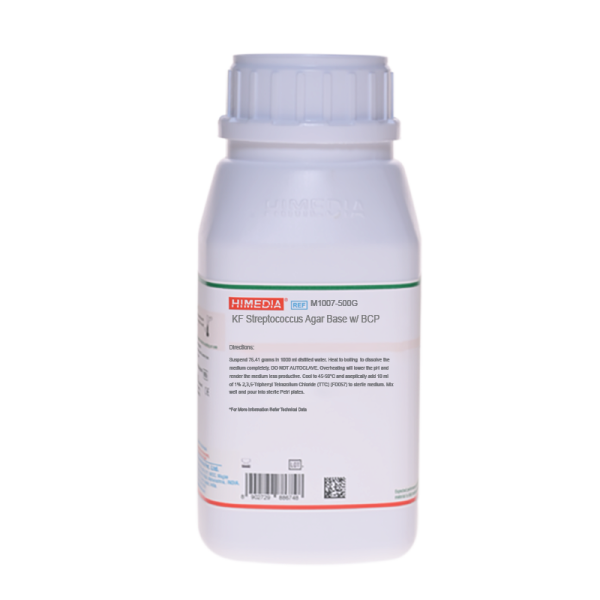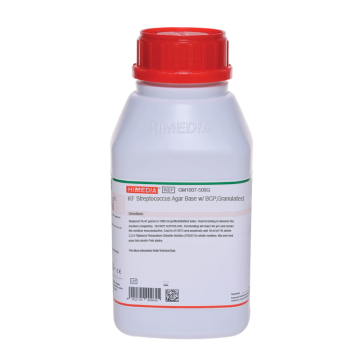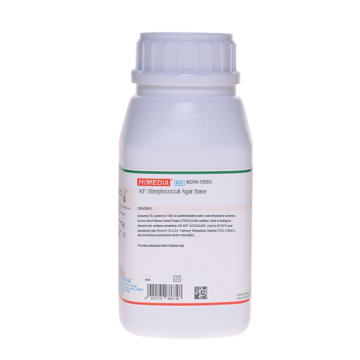 Your enquiry has been submitted
Your enquiry has been submitted
KF Streptococcus Agar Base w/ BCP
Plate Count#CC293D
Intended Use
Recommended for detection and enumeration of faecal Streptococci from clinical and food samples.
Composition**
| Ingredients | g/L |
|---|---|
| Proteose peptone | 10.000 |
| Yeast extract | 10.000 |
| Sodium chloride | 5.000 |
| Sodium β-glycerophosphate | 10.000 |
| Maltose | 20.000 |
| Lactose | 1.000 |
| Sodium azide | 0.400 |
| Bromocresol purple | 0.015 |
| Agar | 20.000 |
| Final pH (at 25°C) | 7.2±0.2 |
**Formula adjusted, standardized to suit performance parameters
Directions
Suspend 76.41 grams in 1000 ml distilled water. Heat to boiling to dissolve the medium completely. DO NOT AUTOCLAVE. Overheating will lower the pH and render the medium less productive. Cool to 45-50°C and aseptically add 10 ml of 1% 2,3,5-Triphenyl Tetrazolium Chloride (TTC) (FD057) to sterile medium. Mix well and pour into sterile Petri plates.
Principle And Interpretation
Streptococci are spherical, gram-positive bacteria and form a part of the normal commensal flora of the mouth, skin, intestine, upper respiratory tract of humans. Streptococci found in the faeces form the faecal Streptococci and constitute of Streptococci with group D Lancefield antigens. The types include Streptococcus faecalis, Streptococcus faecium, Streptococcus bovis and Streptococcus duran. They are low-grade pathogens and rarely cause disease. However, they may cause urinary tract infection in catheterized patients; mixed abdominal wound infections following gut surgery; and endocarditis on abnormal valves. Kenner - Faecal (KF) Medium were developed by Kenner et al (1,2) for detecting Streptococci in water and food materials. Proteose peptone along with yeast extract provide nitrogen, carbon, sulphur, amino acids, vitamins and trace ingredients to the faecal Streptococci. Lactose and maltose are the fermentable carbohydrates and therefore serve as energy sources. Sodium azide is a selective agent, which hampers the growth of gram-negative bacteria. 2,3,5-Triphenyl Tetrazolium Chloride is reduced to insoluble formazan by actively metabolizing cells, resulting in the formation of pink or red colonies. Bacteria resistant to azide, utilize lactose and / or maltose. The acidity so produced changes the colour of the indicator dyes to yellow. Bacterial cells reduce TTC to insoluble formazan, resulting in the formation of pink to red colonies.
Type of specimen
Clinical samples - faeces, Food and Water samples.
Specimen Collection and Handling:
Samples can be directly streaked or sterile membrane filters through which the water samples have been passed are aseptically placed on the media. After an incubation at 35-37°C for 24-48 hours, Enterococci appear as pink to red colonies. After this presumptive identification, further confirmatory tests should be carried out (3,4). After use, contaminated materials must be sterilized by autoclaving before discarding.
Warning and Precautions
In Vitro diagnostic Use. For professional use only. Read the label before opening the container. The media should be handled by trained personnel only. Ear protective gloves/protective clothing/eye protection/face protection. Follow good microbiological lab practices while handling specimens and culture. Standard precautions as per established guidelines should be followed while handling clinical specimens. Safety guidelines may be referred in individual safety data sheets.
Limitations:
- KF medium was devised to detect fetal contamination in water and is not specific for presumptive identification of the group D Streptococcus species, further tests are required along with KF (4).
Performance and Evaluation
Performance of the medium is expected when used as per the direction on the label within the expiry period when stored at recommended temperature.
Quality Control
Appearance: Cream to greyish yellow homogeneous free flowing powder
Gelling: Firm, comparable with 2.0% agar gel.
Colour and Clarity of prepared medium: Light purple coloured, clear to slightly opalescent gel forms in Petri plates
Reaction: Reaction of 7.64% w/v aqueous solution at 25°C. pH: 7.2±0.2
pH: 7.00-7.40
Cultural Response
Cultural characteristics observed with added FD057, after an incubation at 35-37°C for 48-72 hours.
| Organism | Inoculum (CFU) | Growth | Recovery | Colour of colony |
|---|---|---|---|---|
| # Klebsiella aerogenes ATCC 13048 (00175*) | >=104 | inhibited | 0% | |
| Enterococcus faecalis ATCC 29212 (00087*) | 50-100 | good-luxuriant | >=50% | red-maroon |
| Escherichia coli ATCC 25922 (00013*) | >=104 | inhibited | 0% |
Key: (*) - Corresponding WDCM numbers (#) - Formerly known as Enterobacter aerogenes
Storage and Shelf Life
Store between 10-30°C in a tightly closed container and the prepared medium at 2-8°C. Use before expiry date on the label. On opening, product should be properly stored dry, after tightly capping the bottle in order to prevent lump formation due to the hygroscopic nature of the product. Improper storage of the product may lead to lump formation. Store in dry ventilated area protected from extremes of temperature and sources of ignition. Seal the container tightly after use. Product performance is best if used within stated expiry period.
Disposal
User must ensure safe disposal by autoclaving and/or incineration of used or unusable preparations of this product. Follow established laboratory procedures in disposing of infectious materials and material that comes into contact with clinical sample must be decontaminated and disposed of in accordance with current laboratory techniques (5,6).
Reference
- Kenner B. A., Clark H.F. and Kabler P. W., 1960, Am. J. Public Health, 50:1553.
- Kenner B. A., Clark H. F. and Kabler P. W., 1961, Appl. Microbiol., 9:15.
- Facklam R. R. and Moody M. P., 1970, Appl. Microbiol., 20:245.
- MacFaddin J. F., 1985, Media for Isolation-Cultivation-Identification-Maintenance of Medical Bacteria, Vol. 1, Williams and Wilkins, Baltimore.
- Isenberg, H.D. Clinical Microbiology Procedures Handbook 2nd Edition.
- Jorgensen, J.H., Pfaller, M.A., Carroll, K.C., Funke, G., Landry, M.L., Richter, S.S and Warnock., W. (2015) Manual of Clinical Microbiology, 11th Edition. Vol. 1.
- Lipps WC, Braun-Howland EB, Baxter TE, eds. Standard methods for the Examination of Water and Wastewater, 24th ed. Washington DC:APHA Press; 2023.
| Product Name | KF Streptococcus Agar Base w/ BCP |
|---|---|
| SKU | M1007 |
| Product Type | Regular |
| Physical Form | Powder |
| Origin | Animal |
| Packaging type | HDPE |
| References | 1.Kenner B. A., Clark H. F. and Kabler P. W., 1960, Am. J. Public Health, 50:1553. |
| Customized Product Available | No |










